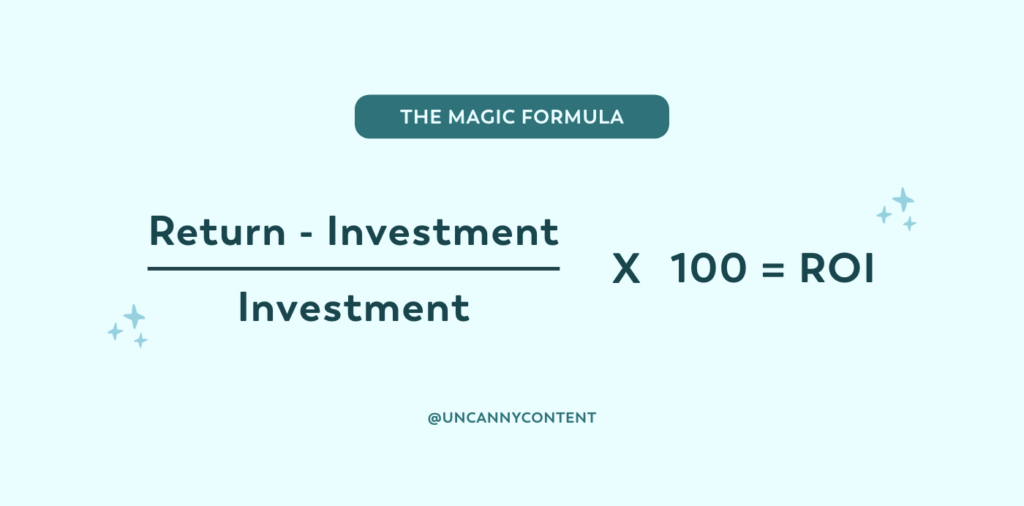When you’re in the content marketing game, sometimes it feels like you’re just throwing content at the wall to see what sticks. Do long blog posts have better engagement than short ones? Sure! Will people like our email newsletters more if there are cat GIFs in it? If they’re cool, they will.
That kind of approach works sometimes, especially when you’re just starting out, but it’s not sustainable. Everyone can benefit from a definitive, data-based strategy to assess whether your content marketing is working or not. Measuring your content marketing ROI is the way to go.
What is ROI?
ROI stands for “return on investment.” When it comes to content marketing, ROI allows you to determine the profitability of your marketing efforts. In even simpler terms, measuring ROI helps you figure out if your content marketing is worth your time and money.
For every buck you pour into a marketing campaign, how much are you getting back? That’s what you aim to answer when you measure your content marketing ROI. It’s a good way to check in with your content marketing strategy to see what’s working and what could be better.
Also, er…what’s content marketing, again?
Hey, we all need a refresher from time to time. Content marketing is as it sounds: using content (which is more than just blogs) to promote your business, reel in new customers, and keep current customers coming back for more.
Add up the costs of your content marketing strategy
Now that we’ve remembered what content marketing means and learned that ROI helps us understand if we’re doing it right, let’s start calculating. The first step in measuring content marketing ROI is to add up how much it costs to produce and promote your content.
Hold tight, because creating content involves a lot of different costs — some you may not have even thought of:
- Pay to writers, editors, graphic designers, video production teams, content managers, freelancers or independent contractors…anyone hired to create content
- Content creation tools, such as Canva, Yoast SEO, or Photoshop
- Image subscriptions or audio costs
- Proofreading, editing, or transcription costs, if outsourced
That’s content creation done. Content promotion is a whole other department that you need to factor into your cost of investment. Include costs like:
- Social media ads
- Google ads
- YouTube ads
- Email marketing
- Affiliate marketing or influencer marketing
- Content distribution tools like Later, Planoly, etc.
Got your numbers added up? Cool. This number will make up your investment when using the ROI formula. (More on that down below.)
Figure out how much revenue you’ve generated
Time to look at the more fun part of the formula: how much you’re getting back on your investment. This is the return part of the ROI formula.
This is easier than it sounds, because sometimes, you may not be 100% sure which content actually convinced a customer to buy your stuff. They might’ve gotten to your landing page through an ad, but maybe they’re a longtime follower of your blog and read your email newsletter every month. Which gets the credit for the conversion, then?
It’s up to you, but make sure you’re using tracking tools like Google Analytics to see what’s going on behind the scenes.
Use the magic formula for ROI
Ask Google the formula for determining ROI and you’ll get a bunch of results that seem different, but they’re essentially the same. We like the following formula for its simplicity:
[ (Return – Investment)/Investment ] x 100

Someone may use the terms “sales growth” or “revenue” instead of return, or “marketing cost” instead of investment. But you can see that the equation is the same.
Add up how much your content marketing efforts cost, subtract that from the revenue you’ve made, divide that number by your costs, and multiply the whole thing by 100 to get a percentage.
We don’t especially love math — we are in the business of words, after all — but here’s an easy example of how it works.
If you spend $1,000 on content marketing and generate $6,000 in sales or acquired leads, your ROI is
$6,000 (Return) – $1,000 (Investment) = $5,000
$5,000/$1,000 = 5
5 x 100 = 500%
Easy peasy, right? But hang on. There’s more to assessing ROI than just crunching numbers.
Don’t get lost in the numbers
You’ve worked out the numbers and concluded that, yes, your content marketing game is on point, or yikes, you need to step it up. But either way, we recommend you look past the numbers when measuring content marketing ROI.
Some things just can’t be measured easily or deemed a success in terms of sales numbers. That doesn’t mean they’re unimportant or that they didn’t have an impact on your growth. Make sure you look at the qualitative, “unmeasurable” stats like:
- Engagement. Data like lead quality, web traffic, and bounce rate may not lead directly into sales numbers, but they can still tell you if people are interested in your content and spending more time on your site.
- Social media likes, comments, or shares. Again, tons of shares may not truly equal more revenue, but if engagement on your social media pages is up, that’s always great news for your brand.
- SEO success. Is your content ranking well for specific keywords? Is your domain authority high? Then more people are likely to find you when searching online.
Whether your ROI is good enough is up to you. Your definition of success, what you’re measuring, and how you’re measuring it will determine the results of measuring your content marketing ROI.
Need help taking your content marketing to the next level? Give us a ring.

